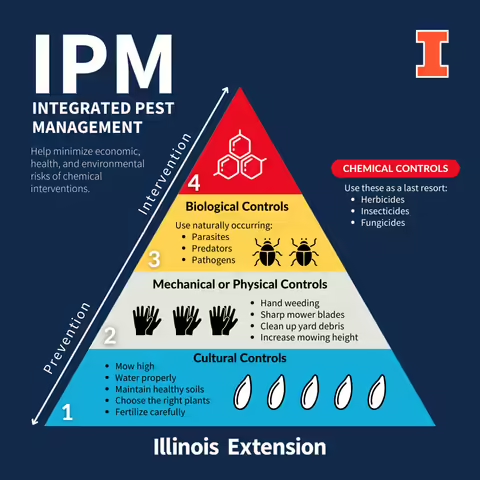URBANA, Ill. – Summer is a period of growth where both landscaped and natural environments are lush and verdant. But not all green is good.
Weeds can alter ecosystems and rob healthy plants of water, sunlight, and nutrients, hindering their growth. Woodlands, prairies, and even hedgerows in urban landscapes can be overtaken by invasive weeds which can look “all-natural.”
Though manual removal of weeds allows for instant gratification, the process takes time and effort. Using cutters and mowers to remove top growth of aggressive, perennial invasives may be useful, but they miss the root of the plant, often resulting in regrowth and frequent cutting is needed.
University of Illinois Extension weed science specialist Michelle Wiesbrook recommends using non-chemical methods first, but responsible and safe use of herbicides can be a part of a well-rounded integrated pest management plan.
Wiesbrook wrote about herbicide use in her most recent article in the Illinois Pesticide Review. Herbicides are commonly used in natural settings to provide a more complete kill and prevent new growth.
“Herbicides are also less labor-intensive, less time consuming, and more economical when looking at large-scale areas,” says Wiesbrook, who works with the Pesticide Safety Education Program.
The program trains about 10,000 commercial and private pesticide applicators on safe use every year.
When used properly, pesticides have many benefits. A 2013 report published by Delta Farm Press estimated that U.S. farmers had a $16 billion boost in crop yield by using herbicides.
Typically, herbicides cut weed control costs associated with hand removal. However, if pesticides are not used carefully and according to product label directions, damaging off-target movement can occur.
Integrated pest management is a sustainable decision-making process that reduces pesticide use by combining different tools such as controlled burns, mechanical controls, and starting with weed-free seeds.
Pesticide training and testing is available through the Pesticide Safety Education Program online at extension.illinois.edu/psep/training-and-testing.
SOURCE: Michelle Wiesbrook, Weed Science Specialist, University of Illinois Extension
WRITER: Erin Wunderlich, Writer, University of Illinois Extension
ABOUT EXTENSION: Illinois Extension leads public outreach for University of Illinois by translating research into action plans that allow Illinois families, businesses, and community leaders to solve problems, make informed decisions, and adapt to changes and opportunities.
